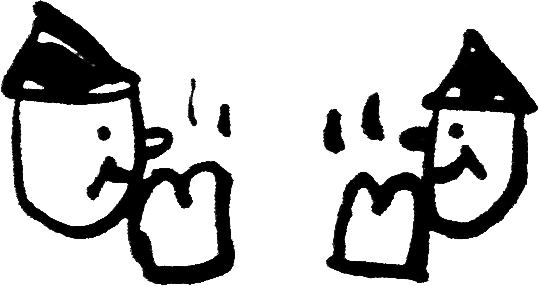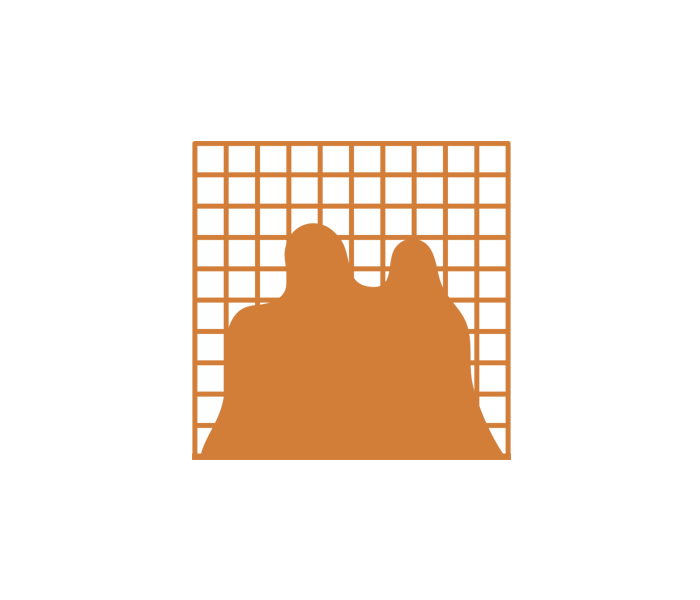Two phases of workshop
The main workshop activity contains two folds: 1) self-discovery and 2) sharing stories together. The balance between time on your own and spending with others is the focal point of the workshop since self-construction is achieved through inside sources from self and outside sources from others. Memories, feelings, ideas, beliefs and subjectivity come from our inner self, and more importantly interaction with others also shapes who we are and who we want to be like.
1) Self-discovery was considered in the first activity – conscious and unconscious aspectes of human mind.
Self-portrait has been chosen to visualize conscious self-visualization. The tool, however, also had to reveal unaware aspects of self, regardless of participants' artistic skills. Therefore, projective drawing technique and expressive theraphy were combined as a means of visual storytelling of oneself. Projective drawing is designed to lead people to express their inner world, hidden feelings, and internal conflicts by drawing general figures like human, tree and house. Moreover, when multiple senses are involved, people communicate deeper aspects of memories and stories that may not be easily revealed through verbal or visual conversation.
2) Food making as multi-sensory storytelling and socializing tool
Multi-sensory storytelling stimulates personalized experiences by evoking emotional feelings, showing personal thoughts and experiencing empathic communication. In that sense, food has been actively used as tool for communication. We all need food. Eating food is not only about taste, but also related to other senses. Therefore, utilizing the very basic materials which are edible seems to be logical means to connect people. In addition, it is non-judgemental compared to other artistic expression.
As a practice-based research and participatory action research, the project took a form of explorative design workshop to experiment the concept developed by participant engagement.
Island and bread
Starting, stopping, and waiting are all part of the construction to achieve remoteness.
Multiple modes of transportations for crossing the barrier of the sea.
Islands connected beneath the water.
Seasonal bridge by frozen sea in wintertime.
Island possesses the positive concept of isolation and connectivity above and below the water. In today’s ever-connected world, the value of remote places gives positive feelings of escaping from daily life. Island-ness is achived through time and effort including multiple modes of transportation, which build the psychological distance to island. On the other hand, the interplay between water and land provides the poetic concept of connection, both intrinsically and temporarily. Basically, group of islands are connected beneath the water. Besides this, some islands can be accessible by seasonal bridge of the frozen sea or by tidal bridge by uctuating level of water.
'Companion' originates from Latin com 'with' and panis 'bread,' which was used to describe someone with whom you shared a meal.
Bread has been selected because it is universal and staple food in many countries. More importantly, the similarity between bread and land in terms of the appearance and formation process. Lastly, the relationship between people and their surrounding was considered by using sourdough bread. Sourdough bread is made of natural sourdough that is grown by micro organism from our surroundings. Therefore, it reflects the place we live. Also, good sourdough can be shared and used as a ‘root’ of bread from generation to generation, which is associated with the connection between people.
Air is one of the invisible ingredients from our surroundings that complete true sourdough bread synthesized by a local micro-organism.
From self to island
1) How do you look?
The visual quality of island in size and shape is the first question by which participants began with free hand drawing. Participants were asked to draw their island in profile for visual information of volume and height. This question could be associated with their potentiality, generosity, ambition, energy, or strengths of the ego.
2) Is your land soft or rough?
Following the visual elements, texture was then introduced. Roughness of the land could be expressed in many ways: self-control, openness, the need for security or receptivity.
3) Now begin to add water. How deep is the sea level?
Water is the element that defines an island. We assumed that how people expressed their water level reflected how they wanted their land to be exposed or hidden could re ect sociality, desire for attention, openness or secretiveness.
4) What kind of living things exist on your island?
An ecosystem may refer to social life. Participants could consider social engagement if their island is inhabited. There may also be flora and fauna depending on personal interest or awareness of the things going on around them.
5) What would your island smell like?
This olfactory question is the most imaginative one which relates to the surroundings of island, allowing unexpected extra features or twists to be involved. There is no specific assumption regarding any personal characteristics that match a certain smell. Rather, the ambiguity contributes to evoke the mood of an imaginary world of inner islands.
6) Name you as an island.
Naming refers to identity. Participants are asked to decide the name of their island, which may reveal the main theme of their island, or they could just go with the flow.
From island to bread
Once a drawing is completed, a list of the characteristics describing people’s islands turn into a visual recipe for their island as bread. Each question, other than the last one about name, is linked to main ingredients of sourdough bread – flour, water, and additive ingredients for flavor and scent. The linkages are resulted from intuitive ideas concerning the relevance to bread with the purpose of diversifying the multi-sensory qualities of bread.
1) Size and shape: amount of flour
Flour is the component that determines the volume of the bread. A drawing sheet contains a square divided into 10 by 10 squares in the middle and the scale of roughness of island below. Therefore, the amount of flour is calculated based on the number of squares an island covers.
2) Roughness: proportion of rye flour to wheat flour
Roughness is directly relevant to the texture of bread. Rye flour was chosen because of its rough and rubbly texture compared to normal wheat flour. Also, it is the symbolic ingredient of where we live because the project had been initiated with regard to Finnish environment. The proportion between the two types of flour is decided based on a participant’s mark in the scale of 1 to 10 of roughness.
3) Sea level: amount of water
The sea level organically matches with amount of water used to make the bread.
4) Living things: flavor-related additives or shaping tools
Last two questions intend to enrich the final product of the bread by multi-sensory interventions or by adding more flavors and scents. Participants may find out the difference from others by the sensory qualities that are normally not used for human characteristics. Flora and fauna are transformed into fruity additives and seeds, respectively. The choice of any human inhabitant allows artificial intervention. Shaping tools, such as knife and scissors, were chosen since using tools is a defining feature of human beings.
5) Smell: aromatic additives
The selection of smell is limited into five different options: fresh, sea, floral, forest and exotic. This helped to simplify the workshop process with less confusion of categorizing the possible variety of scents. Each scent in turn is paired with lemon zest, rock salt, honey, herbs and pepper. Additional ingredients also provided us with opportunities to involve local products that contributed to the close connection between participants as bread-island and the place where they live.
















